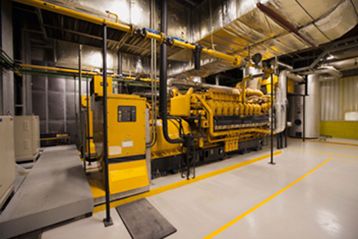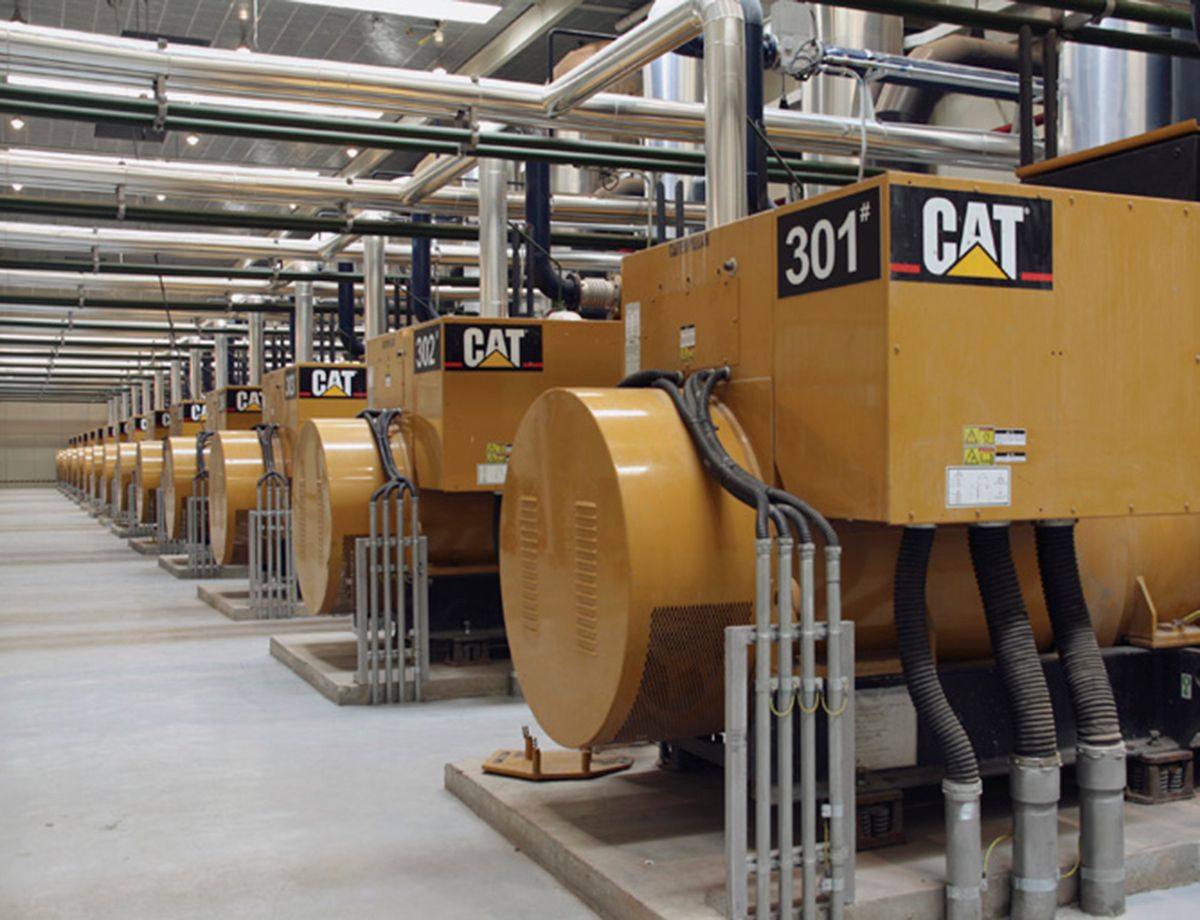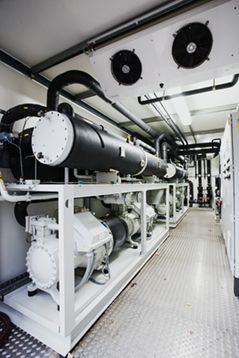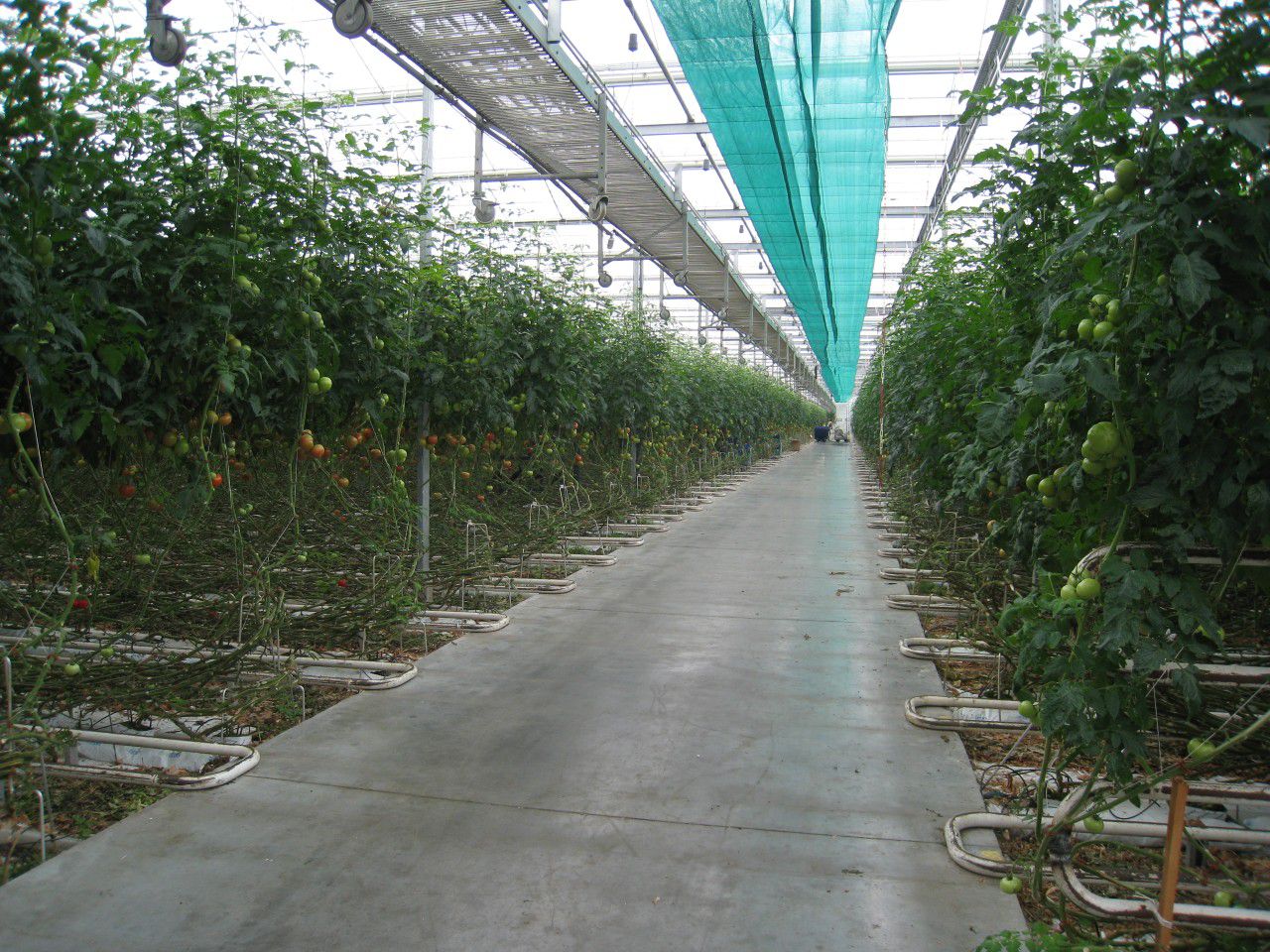DEPLOYING HEAT ENERGY
Hot water and steam are the classical engine outputs in cogeneration systems, but they are not the only ones: They can be converted to other forms to suit additional purposes:
Heated Air
Steam or hot water can be passed through heat exchangers to create hot air to feed equipment such as kilns and dryers. The heated air is mixed with fresh outside air to enlarge the volume and enable precise temperature control.
Chilled Water
Steam, hot water or exhaust can be passed through absorption chillers to produce cold water for space or process cooling. Absorption chillers use heat instead of electricity as the energy source. Their efficiency is measured by coefficient of performance (COP). Simple, relatively low-cost single-effect absorption chillers are activated at temperatures as low as 93° C (200° F); COP typically ranges from 0.7 to 0.9. More complex doubleeffect units, activated at 175° C (347° F), deliver higher COP (1.05 to 1.4), although at greater up-front cost.
Heat-recovery systems can be configured to deploy some heat for water and steam production and the balance to absorption chillers – a concept called tri-generation. Alternatively, systems can produce space heat in winter and air conditioning in summer. For example, in São Paulo, Brazil, energy services company, Ecogen, operates an energy plant that serves the Rochavera commercial office complex that encompasses 8,000 m2 (86,111 ft3) and several office buildings. The energy plant uses a total of four Caterpillar G3520C gas generators sets for a total of 6.4 MWe with jacket water and exhaust gas heat exchangers that capture the engine’s thermal energy and transfer it to a common water circuit that is fed to four 540 ton (TR) rated hot water absorption chillers. The absorption chillers operate in parallel with two 340 ton electric chillers, three 450 ton electric chillers, and a 320 ton natural gas-fired chiller to maintain the facility’s cooling needs. All electrical power generated from the Cat generator sets is then fed through paralleling switchgear and distributed to the campus. Ecogen also employs two G3512B diesel generator sets, each standby rated at 1,500 ekW to provide emergency or peaking power to the facility.
More Electricity
Where a site requires continuous prime power and has little or no heat load; engine exhaust heat can be used to boost electrical output through the organic Rankine cycle. Here the exhaust, typically from multiple engines, feeds a boiler that converts a working fluid to vapor, which in turn passes through a turbine. This configuration, similar to combined-cycle electric power plants, can boost generating capacity by roughly 10 percent and improve electrical efficiency by 5 to 6 percentage points.
Shanxi Jincheng Anthracite Coal Mine Mining Company operates one set of facilities in Jincheng, Shanxi, China. The company collects coal gas from underground coal seams to power four separate power generation plants, each housing fifteen Cat G3520C high voltage generator sets that are integrated via Cat paralleling switchgear and controls. Each powerhouse is designed with a combined-cycle system that recovers waste exhaust heat to power a 3,000 kW steam turbine. The result of this heat recovery scheme is an additional 12 MW of electrical power to the local grid, which is equivalent to 10% of the power plants’ 120 MW total electrical output.
More Heat
Heat pump technology can extract useful heat from lower-quality heat sources: the engine aftercooler circuit, residual heat from the exhaust downstream from the exhaust heat recovery boiler, and even radiant heat from the engine block. This heat can be used to preheat the engine jacket water heat recovery circuit or for low-temperature space or process heating. Such heat pump installations actually can raise overall system thermal efficiency to slightly greater than 100 percent (based on the fuel low heating value) with the recovery of heat lost due to the latent heat of vaporization in the combustion process (the difference between the low heat value and the high heat value of a fuel).
Using exhaust CO2
Beyond heat recovery, carbon dioxide in the exhaust gas is a usable byproduct of power generation: Engine exhaust rich in CO2 can be cleaned in a catalyst reactor, cooled and fed to a process. In greenhouses, for example, CO2 fertilization helps crops grow faster, improving yields by 10 to 20 percent. Exhaust gas can also provide a low-cost source of CO2 for industrial applications or even for carbonation in soft drink bottling. Taking efficiency to the ultimate level, a single generator set can deliver electricity, space or process heating, space or process cooling, and CO2 – a concept known as quad-generation.
At the Eric van den Eynde Greenhouse in Kontich, Belgium, 95 percent of the electricity generated is sold to the local electric utility based on the premium paid for high-efficiency power. The jacket water, exhaust, first stage aftercooler, and oil cooler heat from two G3516A (1,070 ekW each) generator sets and one G3520E (2,070 ekW) gas generator set are captured and stored in the form of hot water. The hot water is used to stabilize the greenhouse temperatures. Water with a temperature of up to 95° C (203° F) is stored in a 1,200 cubic meter (1,569 cubic yard) tank which acts as a thermal battery. The tank provides hot water at 45° C (113° F) via metallic tubes in the greenhouse. The temperature is maintained between 19° and 21° C (66° to 69° F) throughout the year.
The exhaust gases from the generator sets are scrubbed of nitrogen oxides (NOx), carbon monoxide (CO) and unburned hydrocarbons (CnHm). Selective Catalytic Reduction (SCR) and Oxidation Catalyst systems convert these gases into pure CO2 before they are released to the atmosphere. However, 75 percent of the emitted CO2 is re-introduced as an organic fertilizer into the root structures of the growing vegetables via a network of tubes. The CO2 stream helps boosts crop weight up to 20 percent. The simple financial payback of the complete system was around 3.5 years.
Low-intensity cogeneration
Cogeneration is not limited to highly engineered systems that maximize production of both electricity and heat: Simple and well-conceived heat recovery can improve the economics of many electric power projects with only a modest additional investment. Almost any application that entails roughly 1,000 or more annual operating hours offers potential for economical heat recovery. The only firm requirement is that the value of heat recovered outweighs the added cost of the heat-recovery and control mechanisms.
Heat recovery from the engine cooling circuit is extremely simple: A shell-and-tube or plate-and-frame heat exchanger can produce water at 82° to 99° C (180° to 210° F), depending on the engine jacket water temperature. This water can serve purposes that include space or domestic water heating, light production process heating, and boiler condensate or make-up water preheating, as well as air conditioning, process cooling, and desiccant dehumidification.
In each case, the recaptured heat displaces some costs for fuel or utility electricity. To the extent that the recovered heat supports energy needs during times of peak electric load, total demand and thus demand charges are also reduced. Examples of lowintensity, limited-duty cogeneration include:
- Commercial Real Estate- Office buildings can cost-effectively operate generator sets during business hours, avoiding utilities’ highest time-of-use rates. If heat recovery from a jacket-water heat exchanger can partially offset the cost of fuel for space heating, water heating or dehumidification, then return on investment improves.
- Light Industry- A small or mid-sized manufacturer with an on-site generator set could install a heat exchanger in the engine cooling system loop, with a thermostatically controlled diverter valve to regulate the flow to the in-plant load, thus cost-effectively satisfying a variable hot-water requirement.
- Hospitality- Hotels can readily use heat recovery for domestic hot water, laundries, kitchens or swimming pool heaters. In summer, the recovered heat can power absorption chillers or desiccant dehumidifiers for space conditioning.
- Food Processing- Food producers can recover exhaust and jacket water heat to create low-pressure steam for light process loads such as cooking or raising dough, or to produce hot water for cleaning and sanitizing. Depending on the size and character of the heat load, such systems can be cost-effective in single- or multiple-shift service, even if heat demand is cyclical or seasonal.
Engine technology well suited for CHP
Advances in gas engine technology have been essential to progress in cogeneration. By nature, gas engines serve well as isolated or grid-connected on-site power sources. They offer high power density, low first cost per kilowatt, and quick, simple installation. Fuel and operating costs are competitive; emissions are clean; service is readily available with an abundance of trained and qualified technicians worldwide.
The basic engine technology is highly reliable – uptime can approach 98 percent including all maintenance and repairs. Engines readily handle full or part loads, tolerate varied altitudes and ambient conditions, and can be brought online quickly. The latest engines develop high power output in footprints up to 50 percent smaller than traditional units, fitting easily in small engine rooms or containerized power plants.
Gas engines are well suited to operate in cogeneration service on refined natural gas and propane, as well as on fuels of variable heating value and purity. Landfill gas, agricultural biogas and wastewater treatment plant digester gas may produce exhaust containing corrosive compounds, requiring stainless steel surfaces in exhaust gas heat exchangers, but no special modifications are required for heat recovery from liquid cooling circuits. Other specialty gases like coke gas and coal mine methane are also viable cogeneration fuels.
The latest engines, proven in multiple applications worldwide, use a variety of digital microprocessor-based monitoring and control technologies that include:
- Air/fuel ratio control based on charge air density, maintaining NOx emissions within the tightest available tolerance under all ambient and load conditions, irrespective of changes in air temperature and humidity
- Air fuel ratio control based upon Total Electronic Management (TEM) systems that optimize generator set performance, measuring each cylinder’s temperature and adjusting combustion to minimize fuel consumption and engine emissions, and prevent detonation.
- Control system strategies that can be configured to control functions beyond the engine itself, such as radiator motors, electrical breakers and systems, and even a complete cogeneration plant
- Detonation sensing by individual cylinder with automated control to retard timing if detonation occurs
These engines are designed with intake systems that enable efficient airflow and minimize heating of charge air, increasing the air/fuel charge to the cylinders for optimum performance. An open-chamber cylinder design and low-pressure fuel system (0.35-35 kPa (0.5 to 5 psi)) eliminate the need for a fuel compression skid, and the skid’s subsequent cost and ongoing operational expense. Other advances in engine technology include:
- Optimized air and exhaust flow- Both the inlet and the exhaust system are tuned to enable highly efficient, laminar flow. A technology called Pulsed Energy Advanced Recovery Line (PEARL) uses flow-optimized exhaust pipes that convey a constant exhaust mass flow to the turbochargers. Each PEARL module evacuates the exhaust of two cylinders. Exhaust flow is timed so as to keep the turbocharger spinning at the optimum speed over the engine’s entire operating load range. Precise ignition timing, automatically adjusted by cylinder for fuel quality changes, augments this entire process.
- Miller cycle- This adjustment in the combustion cycle by itself increases fuel efficiency by about one percentage point. The Miller cycle differs from the more traditional Otto cycle in that the intake valves close not when the piston reaches bottom dead center but at typically 10 to 15 degrees before bottom dead center (in the early inlet close version). As the piston continues down with the intake valves closed, the air/fuel mixture expands and cools, increasing the detonation margin. This enables a higher compression ratio of 14:1 or 15:1, versus 11:1 or 12:1 for the Otto cycle – translating to higher fuel efficiency.
- High-energy ignition- Prechamber spark plug technology has been improved with optimized plug geometry. These spark plugs admit air and fuel through small orifices and upon ignition eject flame through those same orifices. High-energy ignition coupled with prechamber plug technology enables the engine to operate on an extremely lean fuel mixture without risking lean misfire, thus sustaining high power output and low emissions over extremely long life spans.
CUSTOMIZED APPROACHES
In recent years, an alternative approach to off-the-shelf engines has emerged in the form of individual generator sets customized to fit the application. In this model, rather than purchase an engine and accessory package based on published ratings and a price list, users provide a sample of the fuel expected to be used, describe the ambient conditions and altitude, and specify the application and key operating objectives (e.g., top fuel economy, lowest emissions, block loading capability, etc.). The manufacturer then custom designs a gas engine-generator system to fit those criteria.
The breadth of customization is considerable: For example, application engineers can select from a variety of compression ratios, pistons designed for specific fuel types, different turbochargers and nozzle ring configurations, and site-specific air system operating and engine timing maps. The customized units come with further advances in engine technology that expand the limits of engine control and reach new heights of efficiency – up to 44 percent electrical efficiency in the generator sets alone and up to 90 percent total plant efficiency in cogeneration or trigeneration service. Advances include:
Lower maintenance costs
Among their benefits, these technology advances contribute to a new paradigm in maintenance intervals. The intervals for spark plug replacement and oil changes are designed to be the same, at 4,000 hours – some six months of continuous operation, or more than double the interval expected with traditional technology. After roughly eight hours of planned downtime for service, the engine is ready to run for another six months. Cylinder head overhaul intervals are at approximately 32,000 hours, and major overhaul intervals are approximately 64,000 hours (fuels containing contaminants or impurities may dictate shorter intervals).
Operating costs are further reduced by lowering oil consumption: Engine technology innovations have cut oil consumption by as much as half, a savings of 1890 litres (500 US gallons) and $10,000 per year on a 20-cylinder engine-generator rated at 2 MW.
AN ECONOMIC DECISION
Every cogeneration project comes down to a question of economics: Will savings on energy costs and revenue from electricity generated provide adequate return on the investment in equipment? In general, the outlook is most favorable where:
- The utility electricity cost is relatively high
- The fuel price is relatively low
- The system will operate with a high electrical and heat load factor
- Electric and thermal loads coincide during a typical day
- The site requires high reliability and power quality
- The cogeneration system can double as a standby power source
The availability of a low-cost “opportunity fuel,” such as anaerobic digester or landfill gas, generally improves the economics. Digester gas-fueled cogeneration in particular is a key contributor in a growing quest for energy self-sufficient wastewater treatment plants.
In exploring project design alternatives, engine fuel efficiency is just one of many considerations. For example, capacity factor – the percent of total theoretical output the generators actually achieve – may far outweigh fuel savings. Furthermore, if high efficiency comes at the cost of increased downtime from more frequent maintenance or engine sensitivity to fuel variability or quality, or if performance is degraded at higher ambient temperatures, then project economics are compromised. Other engine capabilities like low emissions or fast response to block loads may also be more important than fuel economy in some settings.
Checking feasibility
For the development of most CHP projects, it takes specialized expertise to determine how best to deploy the equipment on a site and to evaluate the project economics. So, before investing in a full feasibility study, it makes sense first to check for fatal flaws – physical or cost barriers that would make the project impractical. For example:
- Will it be impossible or extremely expensive to acquire an air-quality permit?
- Will it be difficult to secure a wastewater permit to discharge cooling water or exhaust condensate?
- Is the available space on the site too small to accommodate the engine and heatrecovery equipment?
- Will the natural gas service need a costly upgrade to deliver the necessary fuel?
- Is the facility’s electric power infrastructure inadequate to distribute the generated power?
- If the project success calls for excess electric energy generated to be exported to the grid, do local utility policies preclude such sales?
- If exporting power to the local utility is possible, is the power purchase price available too low to allow for profitable operation?
If the answer to one or more of these questions is no, then you will want to consider the impact of resolving the issue on the project economics and the impact that the resolution will have on project feasibility.
If there are no obvious show-stoppers, the next step is a high-level look at project economics. This involves estimating and stacking the component costs and savings (or revenues) per kilowatt-hour to arrive at the net benefit. A local power generating equipment dealer can be a good source of reasonable, experience-based estimates.
The major cost components are:
- Fuel – typically the largest item at 60 to 80 percent of project operating cost (unless an “opportunity fuel” is available)
- Capital recovery – principal and interest on the equipment investment
- Operations and maintenance – staffing, components and supplies for daily operations, periodic service and repairs
From the total of these costs, the thermal credit is deducted – the economic value of the recoverable heat. This is typically done by looking at the cost per kilowatt-hour of replacing the existing thermal system with a higher-efficiency system. If the resulting total net cost per kilowatt-hour is significantly lower than the retail price of electricity, including demand charges, then the project probably merits further investigation through an engineering study.
In the analysis, it is essential to understand utility electricity costs in detail, including on-and off-peak energy prices, on- and off-peak demand charges, standby charges and any non-availability penalties, and existing or pending cogeneration incentives from the local utility or government entities.
Ideally, a project should be developed in a cooperative relationship with the local utility. For example, a project that reduces the user’s overall energy costs while helping the utility limit peak demands on its grid provides a win-win – and may even benefit from utility incentives that enhance economic payback.
Another benefit of a cogeneration system is that it can function as a standby power source (although not for life-safety electric loads such as hospital operating suites where diesel standby with on-site fuel storage is required). In today’s emission-conscious environment, demand is growing rapidly for gas-fueled standby generators. Such systems, installed for utility-parallel cogeneration and operated for extended hours or continuously, provide electric power security while also generating revenue.
CHOOSING A PARTNER
Few organizations have the in-house expertise to plan and implement cogeneration projects. Equipment suppliers and consultants can provide vital support from project planning through design, financing, construction, operation and maintenance.
An appropriate project partner should have a deep understanding of cogeneration and a track record for completing profitable projects. Fast service response time, prompt spare parts delivery, and efficient repair and overhaul services are essential – locally based service and technical support can help ensure that a project is properly operated and maintained so that unplanned downtime is prevented and revenue and savings optimized.
The ideal partner offers single-source support for every project phase, including turnkey ability to design, construct and operate the project. One attractive option is to enter a complete, multi-year maintenance and service contract with an equipment supplier. This ensures attentive parts, maintenance and repair service, often with a contractual uptime guarantee, at a fixed, predictable monthly or annual fee.
Financing is a critical component of any cogeneration project. Numerous options are available, including construction and term debt financing for the entire project – power generation system, heat recovery equipment, electrical switchgear and controls, ancillary equipment and buildings.
The time is right
Seldom if ever have market conditions been more favorable for on-site gas-fueled power cogeneration. The time is right for industrial and commercial facilities, institutions, utilities, food processing facilities and other large power users and producers to explore the economic possibilities of cogeneration with today’s gas engine technology.
About the author
Michael A. Devine is Gas Product/Marketing Manager with the Gas Electric Power Group of Caterpillar Inc., based in Lafayette, Ind. He can be reached at Devine_Michael_A@cat.com.













